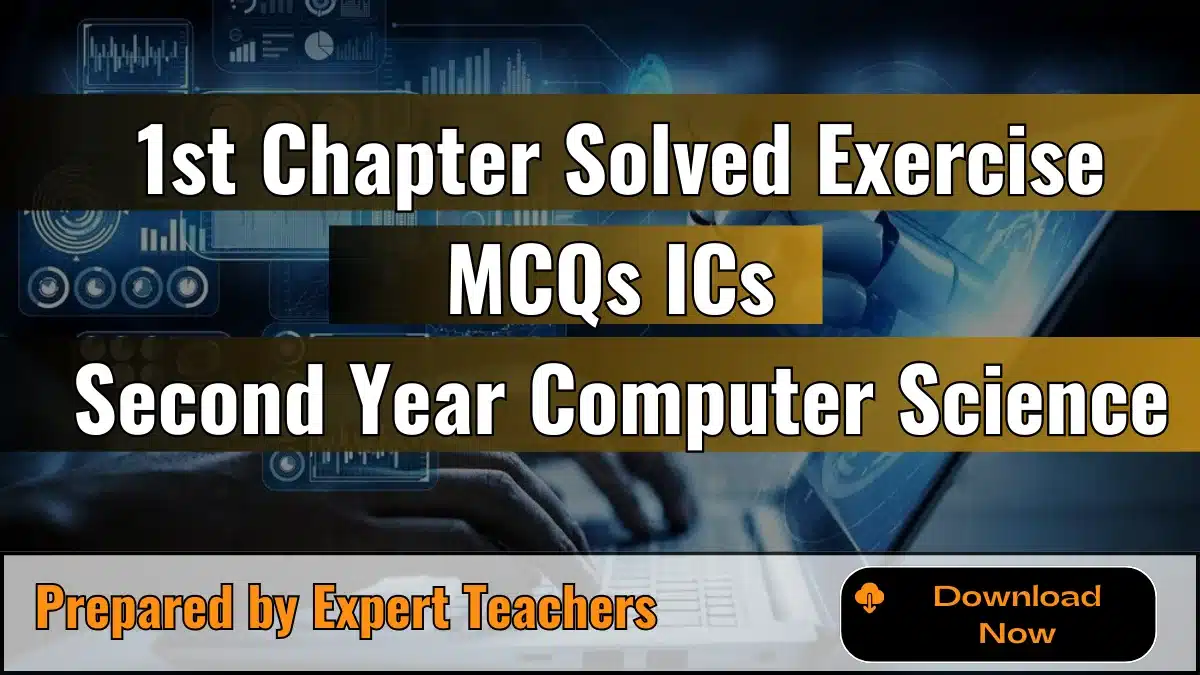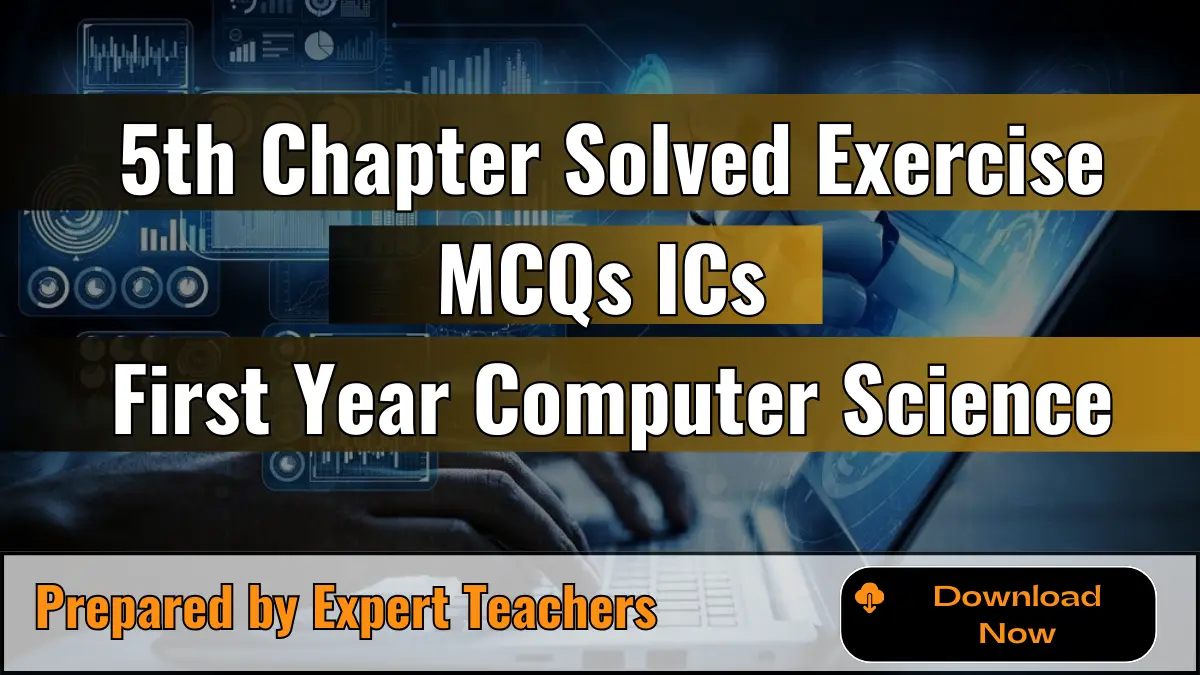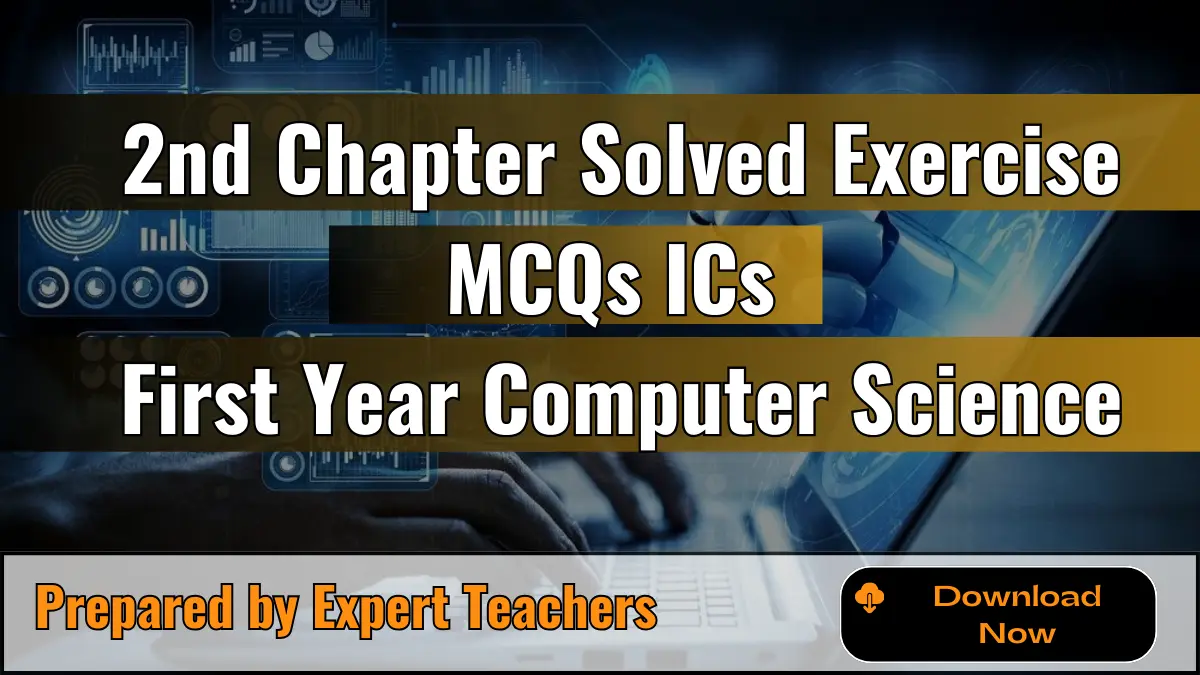1st Year Computer Chapter 3 MCQs and Solved Exercise
These notes provide the most accurate and updated 1st Year Computer Chapter 3 MCQs and Solved Exercise. All questions are based on the topic of Data Communication and follow the board syllabus. Each MCQ is clearly written and comes with the correct answer to help students learn quickly.
The 1st Year Computer Chapter 3 Solved Exercise MCQs are prepared to make revision easier for students. These questions cover all the important points of Chapter 3 and are helpful for self-testing and exam preparation.
If you are a student of 11th Class Computer Science, these MCQs will help you understand the concepts better. All questions are taken from your textbook and presented in a simple format.
These 11th Class Computer Science Chapter 3 MCQs with Answer are also useful for quick revisions before tests or exams. The notes are simple, clear, and focused on what matters most.
Solved MCQs of ICS First Year Computer Science provide a complete set of multiple-choice questions with answers.
1st Year Computer Chapter 3 Solved Exercise MCQs
Perfect for class 11th computer science MCQs preparation, these solved MCQs give you a strong grip on the chapter and help you score better marks.
1. Microwave transmission, coaxial cables, and fiber optics are examples of.
(a) Modems
(b) Communication links
(c) Getaways
(d) Ring network
Explanation: These are physical channels used to transmit data.
2. Data communication requires only a:
(a) Sender
(b) Receiver
(c) Transmission Medium
(d) All of the above
Explanation: Data communication involves a sender, receiver, and transmission medium.
3. BIT stands for
(a) Binary Integer
(b) Binary digit
(c) Binary interval.
(d) None of the above.
Explanation: A bit is the smallest unit of data in a computer.
4. Communication between a computer and a keyboard involves transmission.
(a) Simplex
(b) Half-duplex
(c) Full-duplex
(d) Automatic
Explanation: a one-way communication system where information is transmitted from one device to another, but the receiving device cannot send information back to the transmitting device.
5. The is the physical path over which a message travels.
(a) Protocol
(b) Medium
(c) Single
(d) All the above
Explanation: The physical path over which a message travels is called the medium.
Chapter 3 Solved MCQs for 11th Class Computer Science
Here are 11th Class Chapter 3 mcqs with answers:
1. An example of non-numerical data is:
(a) Address
(b) Marks
(c) Bank balance
(d) Roll No
Explanation: Address typically contains a combination of letters, numbers, and symbols, making it non-numerical data.
2. The chart, graph, pictures, and freehand drawing are examples of:
(a) Image data
(b) Audio data
(c) Numeric data
(d) Text data
Explanation: These are visual representations and fall under the category of image data.
3. The music and speech represent:
(a) Image
(b) Audio
(c) Numeric
(d) Text
Explanation: Music and speech are forms of sound and are categorized as audio data.
4. Which of the following types of data is used to display actions and movement?
(a) Audio
(b) Video
(c) Image
(d) Text
Explanation: Video data consists of sequences of images displayed over time to create the illusion of motion.
5. Which type of data consists of words, sentences, and paragraphs?
(a) Text
(b) Audio
(c) Numeric
(d) Video
Explanation: Text data is composed of characters, symbols, and words used to convey written information.
6. Which of the following is NOT a coding scheme to represent data in a computer?
(a) Unicode
(b) ASCII
(c) Bilateral code
(d) EBCDIC
Explanation: Unicode, ASCII, and EBCDIC are well-known coding schemes for representing data. “Bilateral code” is not a standard term in this context.
7. What binary bits are used to encode digital data?
(a) Os
(b) 1s
(c) 0s and 1s
(d) O to 9
Explanation: Digital data in computers is encoded using the binary system, which consists of only two digits: 0 and 1.
8. Each set of bit patterns is called:
(a) Code
(b) Unicode
(c) Coding
(d) ASCII
Explanation: A specific arrangement of bits used to represent a character, number, or other data is called a code.
9. BCD code is a______bit code.
(a) 4-bit
(b) 6-bit
(c) 7-bit
(d) 8-bit
Explanation: BCD (Binary Coded Decimal) is a 4-bit encoding scheme used to represent decimal digits.
10. Which of the following coding schemes uses a 4-bit code?
(a) ASCII
(b) EBCDIC
(c) BCD
(d) Unicode
Explanation: BCD (Binary Coded Decimal) is the coding scheme that utilizes a 4-bit code for each decimal digit.
11. Which of the following coding schemes is used by IBM?
(a) ASCII
(b) EBCDIC
(c) BCD
(d) Unicode
Explanation: EBCDIC (Extended Binary Coded Decimal Interchange Code) was primarily developed and used by IBM in their mainframe systems.
12. How many characters can ASCII 7-bit code represent?
(a) 128
(b) 256
(c) 500
(d) 364
Explanation: A 7-bit code allows for 2<sup>7</sup> = 128 unique combinations, thus representing 128 different characters.
13. How many characters ASCII 8-bit code can represent?
(a) 128
(b) 256
(c) 500
(d) 364
Explanation: An 8-bit code allows for 2<sup>8</sup> = 256 unique combinations, thus representing 256 different characters.
14. Unicode uses:
(a) 16-bit
(b) 32-bit
(c) 64-bit
(d) 132-bit
Explanation: Unicode primarily uses a 16-bit encoding scheme (UTF-16) to represent a wide range of characters from different languages. (Note: Unicode also has variations like UTF-8 and UTF-32, but 16-bit is a core aspect).
15. How many characters can Unicode represent?
(a) 65,536
(b) 10,000
(c) 15,000
(d) 500
Explanation: A 16-bit code allows for 2<sup>16</sup> = 65,536 unique combinations, enabling Unicode to represent a vast number of characters.
16. How many modes of data communication are available?
(a) 1
(b) 2
(c) 3
(d) 4
Explanation: There are three primary modes of data communication: simplex, half-duplex, and full-duplex.
17. Which of the following is not a data communication mode?
(a) Simplex
(b) Half-duplex
(c) Full-duplex
(d) Auto
Explanation: Simplex, half-duplex, and full-duplex are the standard modes of data communication. “Auto” is not a recognized communication mode in this context.
18. The transmission that allows data to move only in one direction at a time is called:
(a) Half-duplex
(b) Simplex
(c) Full-duplex
(d) Duplex
Explanation: In half-duplex transmission, data can flow in either direction, but only one direction at a time.
19. The mode that is like a two-way street with traffic flowing in both directions at the same time is called:
(a) Simplex transmission
(b) Full Duplex transmission
(c) Half Duplex transmission
(d) Duplex transmission
Explanation: Full-duplex transmission allows for simultaneous two-way communication, similar to traffic flowing in both directions on a two-way street.
20. The transmission in which data can be received and sent simultaneously is called.
(a) Simplex
(b) Full-duplex
(c) Half-duplex
(d) Duplex
Explanation: Full-duplex transmission enables the simultaneous sending and receiving of data.
21. A telephone conversation is an example of:
(a) Full-duplex transmission
(b) Half-duplex transmission
(c) Simplex transmission
(d) Duplex transmission
Explanation: During a telephone conversation, both parties can speak and listen at the same time, which is characteristic of full-duplex transmission.
22. Television and radio broadcasts are examples of:
(a) Full-duplex transmission
(b) Half-duplex transmission
(c) Simplex transmission
(d) Duplex transmission
Explanation: Television and radio broadcasts are simplex transmissions because the information flows in only one direction, from the broadcaster to the audience.
23. Internet surfing is an example of:
(a) Simplex transmission
(b) Half duplex transmission
(c) Full duplex transmission
(d) Duplex transmission
Explanation: Internet surfing involves both sending requests to servers and receiving data back simultaneously, making it an example of full-duplex transmission.
24. Which transmission allows data to travel in one direction at a time?
(a) Simplex transmission
(b) Half Duplex transmission
(c) Full Duplex transmission
(d) Duplex transmission
Explanation: Half-duplex transmission allows data to travel in only one direction at any given moment.
25. The conversation over a walkie-talkie radio is an example of:
(a) Full-duplex transmission
(b) Half-duplex transmission
(c) Simplex transmission
(d) Duplex transmission
Explanation: Walkie-talkies require one person to speak while the other listens, and then they switch roles. This is characteristic of half-duplex transmission.







Leave a Reply